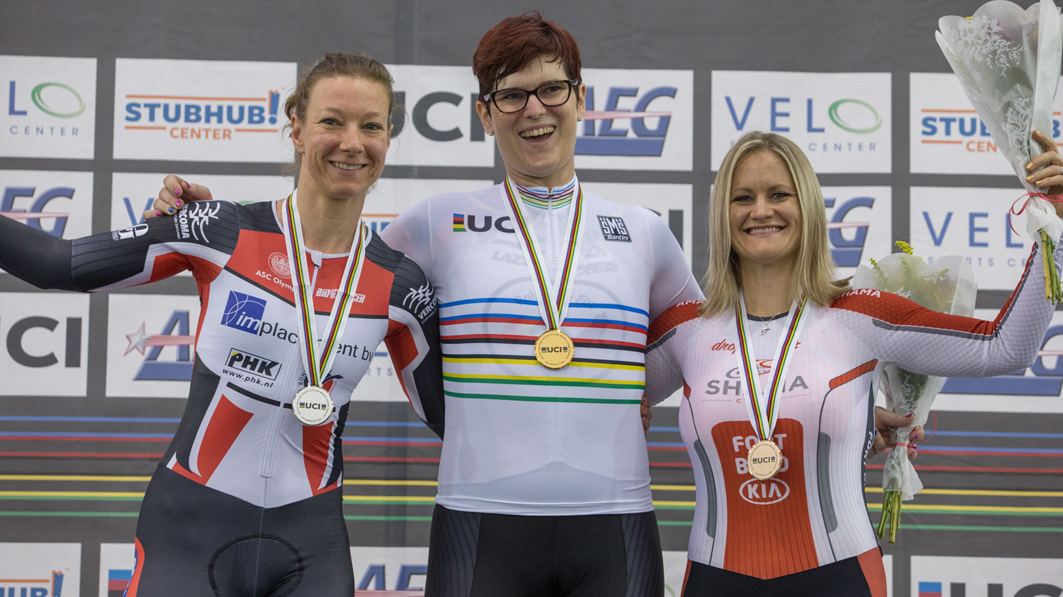For the second year in a row, Canadian cyclist Rachel McKinnon won the Masters Track Cycling World Championships sprint title in the category for women 35-39 years old. The problem? McKinnon was born male and “transitioned” into living as a woman in 2012.
McKinnon faced backlash after last year’s win from athletes and others who were brave enough to say that it’s unfair for someone who’s biologically male to compete in sports against women.
The cyclist says preventing “trans women” competing against women denies their human rights. He also attacked those who questioned his victories as “transphobic bigots” with “an irrational fear of trans women.” He argued that the fact he was born male shouldn’t matter. “My body doesn’t produce testosterone anymore. And it hasn’t for nearly a decade,” McKinnon wrote. Whether that’s due to drugs, surgery or cross-sex hormones, he did not say.
McKinnon is missing the point. It’s not just that now his testosterone levels are low. Because almost every cell in his body has XY chromosomes, McKinnon’s body developed completely differently from a woman’s. Those XY chromosomes are still in his cells. Nothing can change that. In addition, for 30 years his body was producing testosterone, which has lasting effects on his anatomy and physiology.
Gender ideologues claim that there is a distinction between “sex,” which is biological and bodily, and “gender,” which they say is how people think about themselves. This also misses the point when it comes to sports. McKinnon is using his mind when he rides, of course, but his male body is doing the cycling. So even if his mind is female, as he believes – and there is no real research demonstrating this – it’s his male body that’s on the bike. And there are still great differences between his body and a woman’s, whatever hormones he’s taking or surgery he’s had to approximate looking like a woman.
Carol Ann Rinzler, in her book Why Eve Doesn’t Have an Adam’s Apple: A Dictionary of Sex Differences, details many of those male-female differences. It all starts in the womb. For male babies, testis determining factor (TDF) begins working about the seventh week after conception. TDF differentiates the growing embryo so that it develops as a boy. Rinzler writes, “By the time the child emerges from the womb, TDF has done its work. There is no escaping the very real differences between the sexes.”
Because of TDF, the male embryo develops testes that secrete testosterone, “which triggers the development of male reproductive organs, a longer, heavier male body, and a male brain with a relatively larger right hemisphere.”
And that’s just a few of the differences between boys and girls at birth. Researchers found that sex chromosomes, and the hormones they cause the body to create, affect the operation of about 6,500 genes – one third our approximately 20,000 genes. Throughout his development, McKinnon’s male sex chromosomes affected his entire body – down to the cellular level. Those effects aren’t erased because his testosterone output is suppressed or eliminated later in life.
Here are just some of the ways, from Why Eve Doesn’t Have an Adam’s Apple, in which McKinnon’s male body is different from the women he’s competing against, providing advantages in cycling competitions.
- Bones: In young adulthood, “the average woman has 30 percent less mass than the average man.”
- Legs: “A man’s legs are longer in proportion to his trunk than a woman’s are in proportion to hers. This difference almost certainly arises from the longer male adolescent growth period, when the legs grow faster than the body.”
- Hips: “Like the rest of the bones in his body, a man’s hip bones are larger and denser than a woman’s and they are set closer together. As a result, his legs come down straighter, allowing him to move forward in a straight line while walking.”
- Muscle: “Because the male sex hormone testosterone favors the growth of muscle mass, pound for pound the male body is more muscular than the female. The difference begins with the surge of testosterone in adolescence that produces the typical male biceps, shoulder, and thigh muscles.”
- Shoulders: “Broad shoulders are a male secondary sex characteristic. Testosterone makes a man’s shoulder bones broader and his muscles bulkier, giving him upper body physical strength estimated to be as much as three times greater than a woman’s.”
- Skeleton: As a rule, all male bones are larger than the corresponding female bones and show more ‘markings’ – spots where heavier male muscles rub against the bone.”
Researchers from the Bioethics Centre and the Department of Physiology from the University of Otago in New Zealand published a paper earlier this year explaining the unfairness of allowing men who believe they are women to compete against women in sports. The paper, “Transwomen in elite sport: scientific and ethical considerations,” was published in The Journal of Medical Ethics and confirms that biological male-female differences don’t disappear because testosterone levels are lowered.
The authors were very careful to maintain tone and language supportive of transgender ideology, knowing that “any discussion questioning the inclusion of transwomen may be dismissed as transphobic, prejudiced or coming from a lens of cis-normativity.” “Cis normativity” is transgender-ideology language for those of us who know there are two sexes, deny there are multiple genders, and believe people should embrace and identify as their birth sex.
They documented that even when testosterone levels are lowered, the physiological differences don’t change, giving men who compete as women an edge in sports. Taking opposite-sex hormones do have some effects on the body, of course. “However,” the authors stated, “there is very little scientific evidence to provide assurance that such hormone therapy will mitigate the advantage transwomen may have in comparison with cis-women [biologically female] athletes.”
The authors continued, “For example, hormone therapy will not alter bone structure, lung volume or heart size of the transwoman [born male] athlete, especially if she transitions postpuberty, so natural advantages including joint articulation, stroke volume and maximal oxygen uptake will be maintained.”
McKinnon has ruled out competing in the 2020 Olympics, due to injuries from a crash last summer. McKinnon acknowledged it’s possible he could have a physical advantage over women athletes, but says it would be unfair to exclude men who identify as women from female sports.
Biologically Male Runner Decides to Compete as a Woman in College Cross Country
Girls Don’t Chest Bump: Transgender Athletes Subverting Title IX
The Equality Act: Biological Men Competing Against Women in Sports is Problematic
Male and Female: Biology Matters
Male and Female: Why It Matters in the Culture and Public Policy






